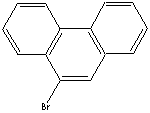PRODUCT IDENTIFICATION

SMILES
c12c3c(c(Br)cc1cccc2)cccc3
CLASSIFICATION
EXTRA NOTES
PHYSICAL AND CHEMICAL PROPERTIES
REFRACTIVE INDEX
EXTERNAL LINKS & GENERAL DESCRIPTION
USA.gov - 9-Bromophenanthrene
Wikipedia Linking - Phenanthrene
Google Scholar Search - 9-Bromophenanthrene
PubChem Compound Summary - 9-Bromophenanthrene
http://www.ncbi.nlm.nih.gov/ - 9-Bromophenanthrene
Local:
Phenanthrene is a tricyclic
aromatic hydrocarbonn (isomeric with anthracene) derived from coal tar; melts at 99 C, boils at 340 C, insoluble in water but is soluble in most organic solvents such as toluene, carbon tetrachloride, ether, chloroform, acetic acid and benzene. It is a white crystalline substance with a bluish fluorescence. It is used in the synthesis of dyes, explosives and drugs. It can be used as a feed stock of carbon black. Phenanthrene and its derivatives are used in the synthesis of dyes, explosives and drugs.
Due to extended pi-electron cloud overlaps, organometallic molecules or aromatic oligometers such as anthracene exhibit semiconductor properties. Conductive polymers have extended delocalized bonds that creates electrical conductivity when charge carriers generated make positive charges (holes) and negative charges (electrons) move to opposite electrodes. Doping is the intentional impurities in a pure semiconductor to generate charge carriers. The transportation of charges is responsible for fluorescence and electrical energy. These can form well-ordered thin crystalline films. Organic semiconductors have some merits of self radiation, flexibility, light weight, easy fabrication, and low cost. Organic electroluminescence materials have lead to the rapid development of photovoltaic and display devices such as organic solar cells, biosensitizers, OLED(Organic Light Emiting Diode), OTFT(Organic Thin Film Transistor), Wearable Display, and e-Paper. Some examples of organic electroluminescence materials are:
- Oligomer Electro Luminescence Materials
- 8-hydroxyquinoline aluminum
- Anthracene
- Pentacene
- Penyl substituent cyclopentadiene derivatives
- Phthaloperinone derivatives
- Perylene derivatives
- Rubrene
- Polymer Electro Luminescence Materials
- Polyanilines
- Poly(p-phenylenevinylene)s
- Poly(thiophene)s
- Poly(alkylfluorene)s
- Poly(acetylene)s
APPEARANCE
99.0% min
MELTING POINT
HAZARD OVERVIEW
GHS (Globally Harmonised System) Classification: Not a dangerous substance. Potential Health Effects: Eyes - May cause eye irritation. Skin - May be harmful if absorbed through skin May cause skin irritation. Inhalation - May be harmful if inhaled. May cause respiratory tract irritation. Ingestion - May be harmful if swallowed.
RISK PHRASES
SAFETY PHRASES